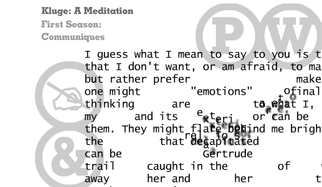
« PREVIOUS ENTRY
Galvez: An imaginary Photoshopped city
NEXT ENTRY »
Stephen Harper eats babies!

A while back I blogged about a cool literary project: A Flash site that delivers the chapter “e” from Christian Bok’s book of experimental poetry, Eunoia. It turns out that the guy who designed the Flash app — Brian Kim Stefans — is both a superb designer and poet himself, and he’s just released another, even cooler art project called Kluge: A Meditation and other works. It’s a collection of interactive poems — bits of shifting text and sound that feel like an intersection of poetry, magic realism and the aesthetics of online advertising.
In “They Said I Was Lonely”, the cursor works like a peephole: You have to move it around the screen to slowly reveal a creepy little stanza and background image. In “A Car Drives to Rome”, the cursor reveals words missing from a dadaist string of proclamations (“A practise has nurses, a beer drowns a fish”), while an Italian voice chirps “Grazie”.
There’s also a series of hilarious “One Letter at a Time” pieces, in which the screen displays the entire text of famous works of art — from Ginsberg’s “Howl” to the script of Star Wars — one letter at a time, accompanied by old-school typewriter clatter. (It’s a cheeky meditation on the idea that while the audience experiences the work as a total whole, the author has to hack through it in dribs and drabs.) My personal favorite of Stefans’ work is the title piece, “Kluge”, in which the cursor slowly erodes the text as you wave it around the page. (That’s a screenshot of it above.)
Stefans describes his technique as …
… the uses of digital technology to expand the techniques that poets use — whether this be in multimedia, interactivity, algorithmic processes, and digital typefaces.
For years, people — particularly in the video-game world — have been heralding the eventual arrival of “interactive narrative”, stories that harness the fluidity of digital media. But the fact is that interactive narrative is an oxymoron. It’s like talking about “dry water”. The audience’s lack of control over a story is the crucial part of what makes narrative narrative. The fun of a good tale is masochistic, submitting yourself to the will of the storyteller; it’s sitting there and going “yeah? And then what happened? And then?” That’s why the best narrative video games (such as the Metal Gear Solid series) are ultimately pretty uninteractive: You can choose from a couple of possible endings, sure, but the basic thrust of the story is set in stone. That’s what makes them good stories.
But here’s the thing: While interactive narrative may be a nonstarter, interactive poetry works admirably well. Think about lyric poetry for a second: The dense reliance on metaphor and imagery; the use of white space as a constituent element. This stuff all lends itself incredibly well to kinetic, plastic, interactive displays, which is precisely why really good online ads already feel like dynamic poems. (You could say the same thing about half of today’s best TV commercials or music videos.) Once you’re dealing with a lyric medium — and most of modern poetry is indeed lyric — interactivity seems to make sense.
(Thanks to Grand Text Auto for this one )
I'm Clive Thompson, the author of Smarter Than You Think: How Technology is Changing Our Minds for the Better (Penguin Press). You can order the book now at Amazon, Barnes and Noble, Powells, Indiebound, or through your local bookstore! I'm also a contributing writer for the New York Times Magazine and a columnist for Wired magazine. Email is here or ping me via the antiquated form of AOL IM (pomeranian99).

ECHO
Erik Weissengruber
Vespaboy
Terri Senft
Tom Igoe
El Rey Del Art
Morgan Noel
Maura Johnston
Cori Eckert
Heather Gold
Andrew Hearst
Chris Allbritton
Bret Dawson
Michele Tepper
Sharyn November
Gail Jaitin
Barnaby Marshall
Frankly, I'd Rather Not
The Shifted Librarian
Ryan Bigge
Nick Denton
Howard Sherman's Nuggets
Serial Deviant
Ellen McDermott
Jeff Liu
Marc Kelsey
Chris Shieh
Iron Monkey
Diversions
Rob Toole
Donut Rock City
Ross Judson
Idle Words
J-Walk Blog
The Antic Muse
Tribblescape
Little Things
Jeff Heer
Abstract Dynamics
Snark Market
Plastic Bag
Sensory Impact
Incoming Signals
MemeFirst
MemoryCard
Majikthise
Ludonauts
Boing Boing
Slashdot
Atrios
Smart Mobs
Plastic
Ludology.org
The Feature
Gizmodo
game girl
Mindjack
Techdirt Wireless News
Corante Gaming blog
Corante Social Software blog
ECHO
SciTech Daily
Arts and Letters Daily
Textually.org
BlogPulse
Robots.net
Alan Reiter's Wireless Data Weblog
Brad DeLong
Viral Marketing Blog
Gameblogs
Slashdot Games